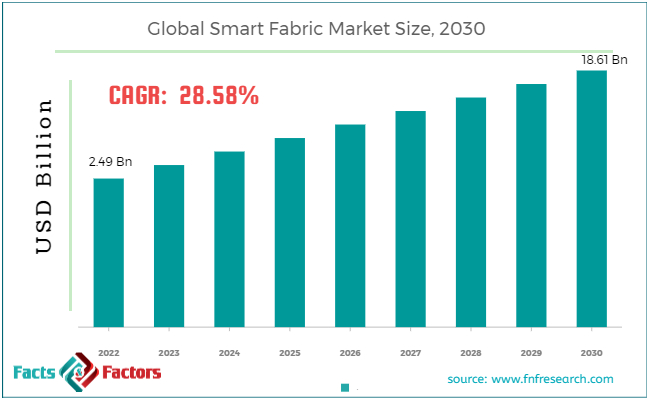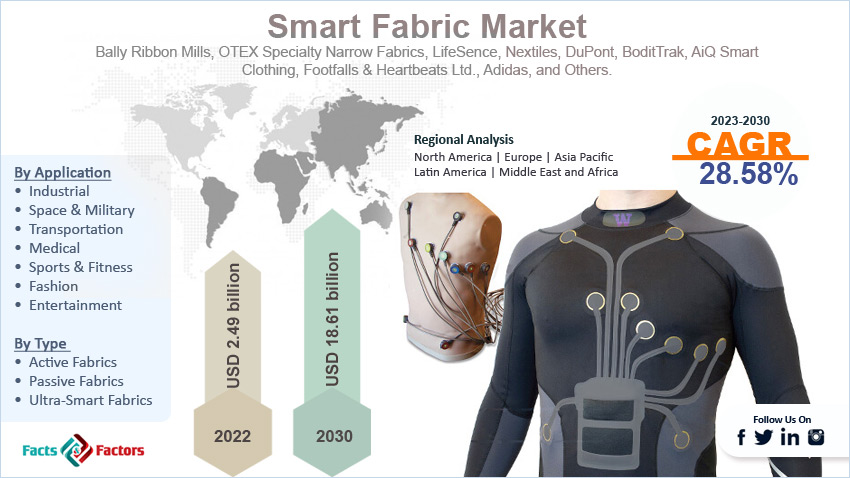Search Market Research Report
Smart Fabric Market Size, Share Global Analysis Report, 2023 – 2030

Smart Fabric Market Size, Share, Growth Analysis Report By Application (Industrial, Space & Military, Transportation, Medical, Sports & Fitness, Fashion, And Entertainment), By Type (Active Fabrics, Passive Fabrics, And Ultra-Smart Fabrics), By Functionality (Sensing, Energy Generation, Aesthetics, And Others), And By Region - Global and Regional Industry Insights, Overview, Comprehensive Analysis, Trends, Statistical Research, Market Intelligence, Historical Data and Forecast 2023 – 2030
Industry Insights
[222+ Pages Report] According to Facts and Factors, the global smart fabric market size was valued at USD 2.49 billion in 2022 and is predicted to surpass USD 18.61 billion by the end of 2030. The smart fabric industry is expected to grow by a CAGR of 28.58%

 Market Overview
Market Overview
Smart fabrics are textiles engineered to incorporate sensors, electronic components, and other advanced technologies to more enable advanced functions than the traditional capabilities of regular fabrics. These fabrics are a large part of smart textiles, which combine textile materials with technologies to innovate new functional products. These fabrics offer a wide array of applications across different industries, which offer functionality, comfort, and enhanced performance.
 Key Insights
Key Insights
- As per the analysis shared by our research analyst, the global smart fabric market size is estimated to grow annually at a CAGR of around 28.58% over the forecast period (2023-2030).
- In terms of revenue, the global smart fabric market size was valued at around USD 2.49 billion in 2022 and is projected to reach USD 18.61 billion by 2030.
- Increasing demand for wearable technologies is driving the growth of the global smart fabric market.
- Based on the application, the space and military segment is growing at a high rate and is projected to dominate the global market.
- Based on the type, the passive smart fabric segment is projected to swipe the largest market share.
- Based on the functionality, the sensing segment is likely to swipe the larger share of the market.
- Based on region, North America is expected to dominate the global market during the forecast period.

 Growth Drivers
Growth Drivers
- Increasing demand for wearable technologies is likely to drive the growth of the global market.
The surging popularity of wearable devices like smart clothing, fitness trackers, and smartwatches is increasing the demand for smart fabrics in the market. Consumers are looking forward to products that can smoothly integrate technology into their daily lives.
Moreover, the ongoing advancements in nanotechnology, electronics, and material science further contribute to the innovation of more versatile and sophisticated smart fabrics. The advancements in conductive material, energy storage systems, and sensors are also expected to improve the capabilities of these fabrics.
Therefore, such a landscape is expected to accentuate the growth of the global smart fabric market in the forthcoming years. For instance, MIT researchers came up with unique and first event smart fabrics in July 2022 that closely fit the body. The fabrics can easily detect the wearer's posture and movements using a revolutionary production method.
 Restraints
Restraints
- High manufacturing costs are expected to hamper the growth of the global market.
Integration of technologies into the textile sector leads to a higher manufacturing cost. This high cost deters price-sensitive consumers and limits the widespread adoption of smart fabrics. Therefore, such a landscape is expected to hinder the growth of the smart fabric industry in the forthcoming years.
 Opportunities
Opportunities
- Growing industrial applications are expected to foster growth opportunities in the global market.
Smart fabrics are used in industrial settings for a large number of applications like monitoring, workers, health, automation, clothing, and several others. The increasing applications of smart fabric are expected to result in significant developments in the global smart fabric market in the forthcoming years.
For instance, Loomia Technologies partnered with Advanced Functional Fabrics of America (AFFOA) in July 2022. The initiative is aimed at commissioning heated handwear exclusively for recreational or military customers.
 Challenges
Challenges
- Complexity of integration is a big challenge in the global market.
Integrating electronic components into the fabric needs a specialized manufacturing process and skill set. However, the lack of appropriate infrastructure and a talented workforce is expected to create significant challenges in the industry. Furthermore, the complexity of integrating technologies limits the scalability of production, thereby slowing down the growth of the smart fabric industry.
 Segmentation Analysis
Segmentation Analysis
The global smart fabric market can be segmented into application, type, functionality, and region.
By application, the market can be segmented into industrial, space & military, transportation, medical, sports & fitness, fashion, and entertainment. The space and military segment is envisioned to seize the topmost earnings in terms of volume and revenue in the smart fabric industry.
The military sector is highly investing in cutting-edge technologies to improve mission success, soldier capabilities, and overall defense mechanisms. Smart fabrics play an important role in offering enhanced functionality to soldiers, like protection, communication, and sensing. Therefore, it is expected to propel the demand for smart fabrics in the sector.
Also, during military space applications, there is an exclusive need for high performance. These fabrics help soldiers with the integration of sensors, flexibility, durability, and many others, which are ideal for emerging defense field environments. The smart fabrics are integrated into military uniforms and tactical wearables to provide situational awareness, communication capabilities, and real-time health monitoring.
Also, these fabrics are highly used in the military for surveillance and security applications. For instance, integrated sensor textiles are highly used for detection and monitoring in sensitive areas. Also, in space applications, these smart fabrics are utilized for adaptive material spaces and sensors to monitor the health and well-being of astronauts. Therefore, such a landscape is expected to propel the growth of the segment in the global smart fabric market.
By type, the market can be segmented into active fabrics, passive fabrics, and ultra-smart fabrics. The passive smart fabric segment is poised to swipe the largest market share during the predicted period. Passive smart fabrics are low maintenance and are highly preferred by people because of their durability and simplicity.
Also, they don’t need any external power sources, so they are easy to maintain and even offer a longer lifespan. The passive smart fabrics are comfortable and lightweight, making them ideal for sportswear and other sophisticated applications. These fabrics are more cost-effective than other smart fabrics as they do not need any active electronic components.
By functionality, the market can be segmented into sensing, energy generation, aesthetics, and others. The sensing segment is anticipated to grow significantly during the forecast period. Sensing fabrics are manufactured to detect and measure the different parameters. Sensing smart fabrics are highly used in the healthcare industry for tracking patients' health, monitoring important symptoms, and offering real-time data analytics to healthcare professionals.
There is a high demand for non-invasive monitoring solutions in healthcare, and it is the primary reason for the high growth rate of the segment. The surge in the trend of wearable devices like fitness trackers, smart clothing, and others is another important reason driving the demand for sensing smart fabrics. Such fabrics include sensors to measure biometrics, monitor physical activity, and enhance the overall general experience.
 Report Scope
Report Scope
Report Attribute |
Details |
Market Size in 2022 |
USD 2.49 Billion |
Projected Market Size in 2030 |
USD 18.61 Billion |
CAGR Growth Rate |
28.58% CAGR |
Base Year |
2022 |
Forecast Years |
2023-2030 |
Key Market Players |
Bally Ribbon Mills, OTEX Specialty Narrow Fabrics, LifeSence, Nextiles, DuPont, BoditTrak, AiQ Smart Clothing, Footfalls & Heartbeats Ltd., Adidas, and Others. |
Key Segment |
By Application, By Type, By Functionality, and Region |
Major Regions Covered |
North America, Europe, Asia Pacific, Latin America, and the Middle East &, Africa |
Purchase Options |
Request customized purchase options to meet your research needs. Explore purchase options |
 Regional Analysis
Regional Analysis
- North America to dominate the global market.
North America is expected to substantiate a significant share of the global smart fabric market because of the growing advancements in technology. The region is a hub for innovation and research institutions that are actively involved in the research process of smart fabrics.
Big companies are investing heavily in research and development activities to innovate and manufacture smart textile technologies. Consumers in the region are at the forefront of incorporating smart fabric, consumer electronics, and fashion products into their lives. Consumers integrate these technologies seamlessly into their everyday lives, thereby widening the scope of the regional market in the upcoming years.
The healthcare sector in the region is also increasingly inclining toward smart fabrics for various applications like wearable medical devices, smart textiles in hospitals, and patient monitoring. The surge in wearable technology is contributing heavily towards the adoption of smart fabrics in the region. Therefore, such a landscape is expected to positively impact the growth trajectory of the global market.
Asia Pacific is expected to witness significant growth in the global market due to ongoing technological advancements, a high adoption rate of smart fabrics across different sectors, and a surging trend of innovative textiles. The region is a prominent market for consumer electronics and fashion products, which is likely to contribute heavily to its high growth rate.
Several countries in the region like India, South Korea, Japan, and China, are known for their research and technological innovations. Research institutes and companies in these nations are investing heavily to speed up the research process and come up with innovative smart fabric technologies.
Such a landscape is expected to widen the scope of the regional market in the forthcoming years. For instance, Isko collaborated with the Computer Science and Artificial Intelligence Institute (CSAIL) in July 2021 to initiate their research on wearable technology and smart fabrics. Isko is a Turkish denim manufacturer.
 Competitive Analysis
Competitive Analysis
The key players in the global smart fabric market include:
- Bally Ribbon Mills
- OTEX Specialty Narrow Fabrics
- LifeSence
- Nextiles
- DuPont
- BoditTrak
- AiQ Smart Clothing
- Footfalls & Heartbeats Ltd.
- Adidas
For instance, Advanced Functional Fabrics of America (AFFOA) presented an exhibition at the Smart Textiles Summit in April 2022. It’s a place where companies showcase advanced functional fiber preforms and fibers with LED chips.
The global smart fabric market is segmented as follows:
 By Application Segment Analysis
By Application Segment Analysis
- Industrial
- Space & Military
- Transportation
- Medical
- Sports & Fitness
- Fashion
- Entertainment
 By Type Segment Analysis
By Type Segment Analysis
- Active Fabrics
- Passive Fabrics
- Ultra-Smart Fabrics
 By Functionality Segment Analysis
By Functionality Segment Analysis
- Sensing
- Energy Generation
- Aesthetics
- Others
 By Regional Segment Analysis
By Regional Segment Analysis
- North America
- The U.S.
- Canada
- Mexico
- Europe
- France
- The UK
- Spain
- Germany
- Italy
- Rest of Europe
- Asia Pacific
- China
- Japan
- India
- Australia
- Southeast Asia
- Rest of Asia Pacific
- The Middle East & Africa
- Saudi Arabia
- UAE
- Egypt
- Kuwait
- South Africa
- Rest of the Middle East & Africa
- Latin America
- Brazil
- Argentina
- Rest of Latin America
Industry Major Market Players
- Bally Ribbon Mills
- OTEX Specialty Narrow Fabrics
- LifeSence
- Nextiles
- DuPont
- BoditTrak
- AiQ Smart Clothing
- Footfalls & Heartbeats Ltd.
- Adidas
Frequently Asked Questions

Copyright © 2024 - 2025, All Rights Reserved, Facts and Factors


